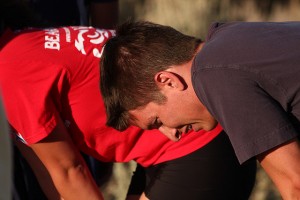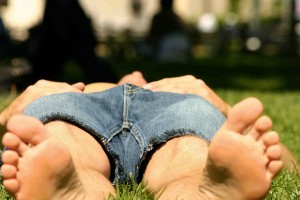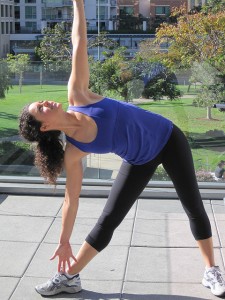General Fitness and Health benefits of cycling to work
![get fit (Flikr - athos[hun] Get fit riding a bike](https://www.ridein.co.uk/wp-content/uploads/2011/11/get-fit-Flikr-athoshun-207x300.jpg) Cycling really can help you to get fit and lose weight. Unlike some other kinds of exercise, like running, it’s very easy to start gently and build up slowly, so anyone can get started.
Cycling really can help you to get fit and lose weight. Unlike some other kinds of exercise, like running, it’s very easy to start gently and build up slowly, so anyone can get started.
Low impact
Cycling is particularly good if you are a little heavier, as it doesn’t put a large strain on your joints. A bike gives you plenty of support and allows you to increase your effort at your own pace.
Offers a challenge
For those who are interested in really challenging themselves, cycling is a great sport. Following a cycling fitness programme, going long distance, hitting the steepest hills around or improving your bike commute time every single day.
Fitter, stronger, wide awake
Cylists are on average fitter than someone tens years younger. And you will soon notice your leg muscles getting firmer and the ride getting easier.
You’ll also arrive more awake, more alert and better able to concentrate for the rest of the day.
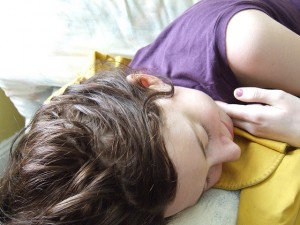 As well as the short-term benefits of getting you fitter and looking better, cycling could also make you feel more positive and have far wider health benefits. There are many positive effects on your well being from cycling.
As well as the short-term benefits of getting you fitter and looking better, cycling could also make you feel more positive and have far wider health benefits. There are many positive effects on your well being from cycling.
Sleep better
Studies have shown that being outside cycling, in the sunlight boosts the body’s natural levels of serotonin, and it will also help you sleep better.
Reduce health risks
Not only that, it may help you live longer with lengthy studies showing that cycling can reduce the risk of heart disease, diabetes, cancer, high blood pressure and obesity.
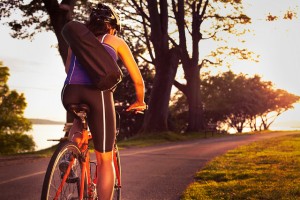 Cycling to work is one of the best ways improve your overall fitness and to lose some weight.
Cycling to work is one of the best ways improve your overall fitness and to lose some weight.
The best thing about it is that it is so easy to integrate into your daily routine – so you don’t have to find much extra time to do it.
What’s more, unlike running for example, cycling is very low impact, so even if you are carrying a bit of excess weight it’s easy to get started with shorter rides and build up.
Building a strong physique by cycling
Depending on several things – including your weight and fitness levels – cycling to and from work will burn around 400-500 calories per hour.
So, as long as you are not overeating, the extra calories burnt will mean that you will shed any excess fat.
Cycling also helps to build muscles, particularly in your legs. Not only will this mean you will appear more toned but a higher proportion of your body will be muscle mass.
More muscle mass means that your body’s base metabolic rate – the speed at which you burn calories at rest – increases. So, you’ll even burn more calories when off your bike.
As well as raising your base metabolic rate, straight after cycling your metabolic rate will be raised higher than usual for several hours, meaning you are burning more calories than usual.
 Is running a better way to get fit?
Is running a better way to get fit?
While mile for mile, running burns more calories and works more muscles groups than cycling, it does have some disadvantages.
Running is high impact and takes its toll on your knee joints if regularly done on tarmac. When cycling, the bike soaks up the majority of any impact.
While running burns more energy per mile, it takes a lot longer to run a mile than it does to cycle one. With running your possible routes are always limited by the distance you can reasonably run. By bike you can go further and explore more.
Running to work isn’t very practical either, especially if you need to carry a change of clothes or if you live more than a few miles form work. By bike, on the other hand, you can transport in all you need and make it longer distance.
 Which muscles does cycling work train?
Which muscles does cycling work train?
Cycling mainly works your major leg muscles. The key muscle groups you use are you quads – the muscles at the front of your thighs – but the glutes, hamstrings and calves are all engaged when you are pedalling.
After a few weeks cycling to work, you will notice your legs feeling stronger and looking more defined.
As well as your legs, riding to work will also strengthen your core back and abdominal muscles. These are used for balance and to keep yourself in position on the bike, especially when climbing hills or riding at speed. Your shoulders, back and chest also get a work out.
Likewise the main arm muscles, your triceps and biceps, will be soaking up the bumps and supporting your body for the entire ride, as well as getting stuck in when you are out of the saddle. While it’s not quite like an hour lifting free weights, it will keep them toned up.
But most of all it is your cardiovascular system which will benefit the most from cycling to work. Working the heart muscle regularly, and making your body more efficient at delivering oxygen to your muscles is simply fantastic for overall fitness.
How fit will I get?
Your overall fitness levels depend on a huge range of variables, including your diet, genetics and the other exercise you do.
However, if you cycle to work every day you will no doubt improve your fitness to a decent degree.
Your overall fitness gains will depend on the distance you cycle and how hard you ride.
Why warm up?
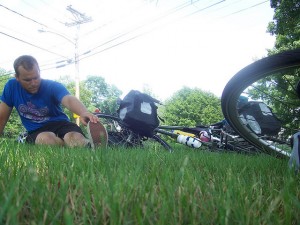 Warming up and down is a personal preference. Some of us are lucky enough to dive straight into intense exercise without feeling as stiff as a board the next day, but most of us will benefit from warming up and cooling down our muscles.
Warming up and down is a personal preference. Some of us are lucky enough to dive straight into intense exercise without feeling as stiff as a board the next day, but most of us will benefit from warming up and cooling down our muscles.
As we get older or start to ride our bikes faster, warming up becomes more important. As you push the body further towards its limits, the risk of straining or tearing a muscle is greater.
Plus on a day-to-day level warming up alleviates muscles stiffness, so you’ll be able to get back on your bike to work day-in day-out.
A warm up helps to get the oxygen flowing to your muscles and allows the muscles and tendons a chance to become more flexible.
Major muscle groups used cycling
Cycling works many muscles in the body but the main ones used are your major leg muscles – the quadricepes, hamstrings and calves. These are the main areas a warm-up should focus on.
Quads
The quads are located on the front of the thigh, running from the pelvis to the knee. This is the muscle which straightens your leg.
Hamstrings
You hamstrings are found on the back of your thigh. They run from the pelvis to the knee on the other side of the leg. These muscles straighten your leg, with help from the buttocks.
Calves
Two muscles in your calf, the gastrocnemius and the soleus, control your foot and toes on the pedal. Regular cycling to work really helps get these defined.
Five step cycle warm up
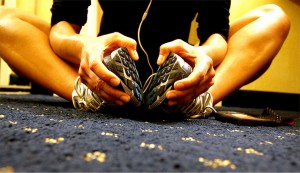 This is a simple five-step warm-up which will help to prepare your muscles for your cycle to work.
This is a simple five-step warm-up which will help to prepare your muscles for your cycle to work.
While it is possible to do a warm up on your bike, it’s actually easier and more effective to stretch the main muscle groups off your bike with a handy bit of wall.
1. Hamstrings
- Stand up straight, pull your knee to your chest and feel the muscle under your leg stretch. Repeat with your other leg.
- Touch your toes – an old classic. Stand with your feet shoulder width apart and bend from the waist as far as possible towards your toes. Hold for 15-20 seconds. Breath in and out while holding and try and stretch a little further on each out breath, but only as far as is comfortable. This stretch also engages your lower back muscles.
2. Quads
- Stand straight and lift one heel up to touch your buttocks, holding it in position with your hand. Feel the stretch along the front of your thigh. Hold for 15-20 seconds. Swap to the other foot
3. Calves
- Put both hands against the wall, with one foot in front of the other. Keep the back leg straight and push your back heel into the ground. Keep a straight upper body and gently lift you hips. Hold for 15-20 seconds. Repeat with the other foot.
- Now move closer to the wall with your feet next to each other. Keep both bands on the wall. Put most of your weight on one leg and bend this knee slightly, keeping the foot flat on the floor. Feel the stretch in your lower calf. To stretch further lean into the wall.
 4. Upper body
4. Upper body
It’s your legs that do most of the work when cycling but you’ll be surprised how much you use the upper body – especially if you have hilly cycle into work.
- Put your hands on your hips and circle your body, ten times one way and then ten the other.
- Windmill both your arms, ten times forwards, then ten times backwards.
- Stretch both hands up to the sky and look up at them. Hold for the count of 10. Now, still looking at your hands, point them to the left about 30 degrees. Hold for 10. Then lean the same distance to the right and hold for 10. You’ll feel a stretch in your torso and up both sides.
5. Neck
Many of us will be cycling in a fair amount of traffic, for at least some of our journey during commuter hours, so we need to keep an eye on what’s going on in front and behind us. This means looking around while riding.
Your neck muscles have a tendency to really go to sleep at night and take a lot longer than other parts of the body to wake up. Make sure you give yours enough time to prepare.
- Lean the head to the left and hold for the count of 5. Then forwards for 5 to stretch the back of the neck. Then finally to the right for 5. Repeat.
- Now put both hand behind your head and push back with your head for 5 seconds. You’ feel a stretch in the front of your neck.
Now you are ready to cycle to work!
